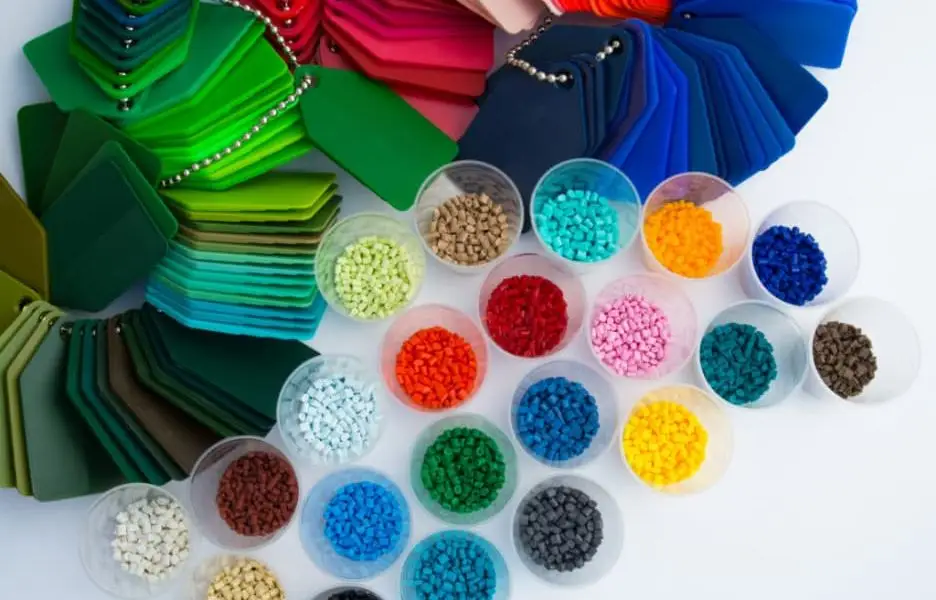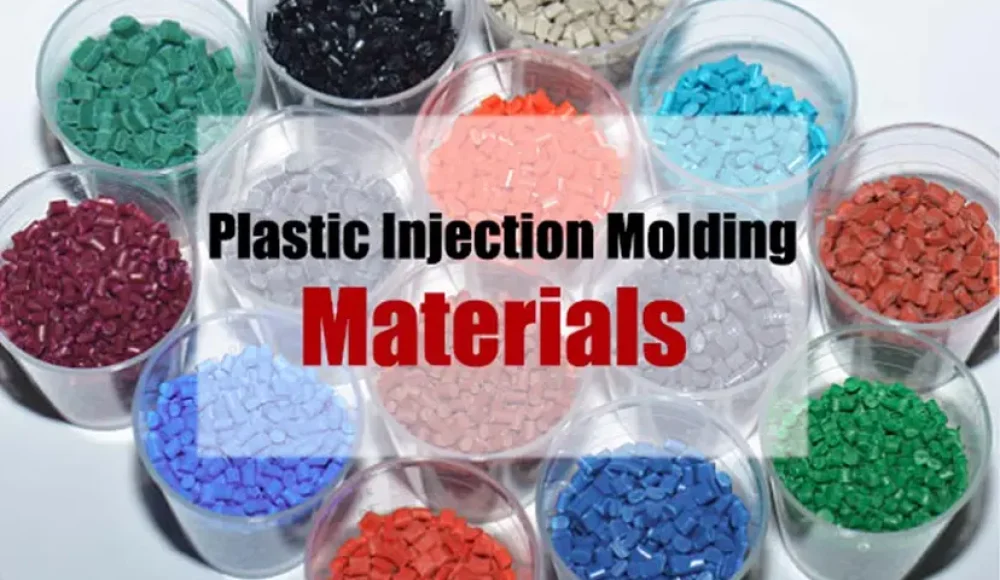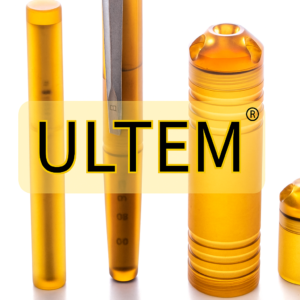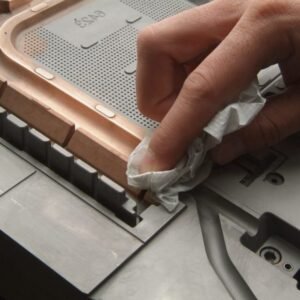適切な材料を選択することは、 injection molding design. The choice of thermoplastic resin determines not only the mechanical strength and durability of a molded part but also its manufacturability, 表面仕上げ, 料金, and long-term reliability.
This guide provides engineers and designers with a structured framework for quantitatively evaluating injection molding materials. It focuses on the key mechanical, 熱の, and chemical properties that influence performance, helping you select the optimal resin for your specific application.
導入

プラスチック射出成形材料
Choosing a thermoplastic resin for injection molding can be a complex engineering decision. Each polymer family exhibits unique characteristics that respond differently to mechanical loads, temperature variations, および環境条件. To make a sound selection, engineers must understand the relationship between material structure and performance, as well as the specific demands of the application.
For safety-critical, high-performance, or reliability-sensitive components, a thorough engineering analysis is mandatory. This includes evaluating stress, 歪み, and environmental exposure to determine which material meets all operational requirements.
しかし, not every project requires extensive simulation or testing. Many molded components operate under mild conditions—such as room temperature and low loads—where common resins like ABS, ポリプロピレン (PP), or polycarbonate (パソコン) are more than adequate. For such cases, simplified guidelines—covered later in this guide under “Don’t Make Me Do the Math”—can help non-engineers make practical and cost-effective material decisions.
Why Material Selection Matters
Material selection often becomes a guessing game when there’s a lack of understanding about:
How internal polymer structure affects properties.
How to clearly define real-world application requirements.
Where to find reliable and comparable data for candidate materials.
Even small variations in resin composition or processing parameters can significantly affect 抗張力, 寸法安定性, or impact resistance. したがって, informed material selection ensures consistent quality, cost efficiency, and predictable performance throughout a product’s lifecycle.
Comparing Common Injection Molding Materials
| Resin Type | 主な利点 | 代表的なアプリケーション | Design Considerations |
| POM (アセタール) | 厳しい, 硬い, 強い, 低摩擦, 疲労耐性 | 歯車, パンプス, インペラ, スイッチ, ノブ | Sensitive to shrinkage; difficult to paint or coat |
| PMMA (アクリル) | Excellent clarity, スクラッチ耐性, low shrink | レンズ, 兆候, light pipes | 脆い, poor chemical resistance |
| ABS | 厳しい, 耐薬品性, dimensionally stable, 低コスト | Electronic housings, handheld devices, cosmetic parts | May show knit lines; thick sections can sink |
| HDPE | 厳しい, インパクト- and chemical-resistant, 軽量 | Containers, おもちゃ, 家具 | High shrinkage, low surface energy |
| パソコン (ポリカーボネート) | 高強度, clarity, そして耐衝撃性 | レンズ, lighting, ハウジング, bulletproof glass | Poor chemical resistance; may bubble in thick parts |
| ABS/PC Blend | Good balance of toughness and processability | 自動車, エレクトロニクス | Lower cost than PC; improved molding properties |
| PP (ポリプロピレン) | フレキシブル, 疲労耐性, 耐薬品性 | Hinges, キャップ, medical tubing | Shrink and warp possible; may void in thick areas |
| ピーク | High-temperature and chemical resistance | 航空宇宙, パンプス, 医療機器 | Very expensive; Ultem or PPSU are cheaper alternatives |
| PEI (究極) | 強い, 耐熱性, dimensionally stable | 医学, lighting, HVAC components | 高い, but cheaper than PEEK |
| PPSU | High heat and chemical tolerance, 滅菌可能 | Medical trays, aircraft interiors | Thick sections may void; limited color options |
| PA (ナイロン) | 高強度, 耐摩耗性 | 歯車, ブッシング, 構造部品 | 水分を吸収します; may warp |
| PBT/PET | Excellent electrical and dimensional properties | アプライアンス, 自動車, 電気 | Prone to warp in glass-filled grades |
| LCP | High flow, 耐薬品性, 低い熱膨張 | コネクタ, PCB | 高い, anisotropic shrink |
| PPS | High chemical and thermal resistance | 自動車, electrical housings | Requires precise crystallization control |
About the Standard Material Data Sheet
あ material data sheet provides essential mechanical and thermal properties—typically measured at room temperature. While these values (例えば, 抗張力, elongation, flexural modulus) are important, they often describe failure conditions rather than real-world performance. Engineers must therefore interpret data sheets carefully, considering environmental conditions, 部分ジオメトリ, and expected loads.
より多い 85,000 commercial plastics exist, grouped into around 45 polymer families. Thermoplastics dominate modern manufacturing, accounting for roughly 85% of all plastic use, while thermosets make up the remaining 15%. Supplementary information from suppliers—like design manuals and case studies—can help bridge the data gaps for engineering-grade materials.
Perfect 👍 Let’s continue and complete the rewritten and SEO-optimized version of your article — picking up from where it left off (“Don’t Make Me Do the Math!」) and finishing it with a strong, educational ending that fits your technical SEO writing style.
Don’t Make Me Do the Math!
Many material property charts show ratios like strength-to-weight または stiffness-to-cost, but in practical mold design, few engineers have time to crunch these numbers manually. その代わり, the best practice is to create a shortlist of viable materials based on mechanical and thermal requirements, それから compare specific, real-world properties (例えば, tensile strength at operating temperature, shrink rate, and melt flow).
Online material databases and supplier datasheets make this easier than ever. Simply filtering by your performance range can narrow hundreds of resins down to a handful of candidates. Once that shortlist is ready, あなたの molder or resin distributor can provide detailed test data for validation and part trials.
プロのヒント: Always test with the ちょうど resin grade you plan to use in production — even small differences in additives, moisture content, or supplier formulations can significantly change flow and shrink behavior.
テストと検証: Never Skip This Step
Material selection doesn’t end at the data sheet. After you’ve identified one or two promising candidates, prototype testing is essential. Build a small pilot mold, run short shots, and inspect critical features. This reveals how the material flows, fills, and warps in your actual part geometry — insights that simulations can’t always predict.
Typical validation checks include:
寸法精度 — Compare measured dimensions with CAD data.
表面仕上げ — Confirm texture replication and gloss levels.
機械的試験 — Evaluate tensile, インパクト, and fatigue performance.
Environmental resistance — Test against chemicals, UV exposure, or temperature cycles.
By catching material-related issues early, you can prevent costly redesigns or warranty claims later.
Partner with Your Molding Expert
Even the most experienced design engineers benefit from collaborating with an experienced molder during material selection. Mold designers and process engineers can advise on:
Proper mold steel choices to match resin abrasiveness or corrosion tendencies.
The need for mold coatings または hot runner compatibility for difficult materials.
調整 ゲートの配置, venting, そして ドラフト角度 for specific resin flow properties.
Their production insight often leads to better long-term consistency and fewer processing challenges — ultimately saving both time and money.
Sustainability and Recycling Considerations
Today’s manufacturing environment places increasing emphasis on sustainability. 可能な場合, 考慮する recycled or bio-based materials. Many resin suppliers now offer PCR (Post-Consumer Recycled) または bio-resin versions of standard polymers such as PP, ペット, and PA.
While these sustainable options can slightly alter mechanical or color properties, they help reduce environmental impact and support greener product initiatives. Always test these materials under real processing conditions to ensure consistent quality.
最終的な考え
Choosing the right injection molding material is one of the most important decisions in part design. The resin you choose determines not only product strength and performance but also 料金, 耐久性, and manufacturability.
Here’s a quick summary to guide your process:
Define your requirements — strength, 温度, chemical exposure, 外観, そしてコスト.
Shortlist materials that meet your property range.
Evaluate process compatibility — shrinkage, moisture sensitivity, 成形性.
Prototype and validate before final selection.
Consult your molder to fine-tune production parameters.
A thoughtful, data-driven approach ensures every molded component meets performance targets and budget expectations — the foundation of reliable, repeatable production.
Internal Linking Suggestions (for WordPress)
13 Types of Surface Finishes in Die Casting




1 「」について考えました射出成形材料選択ガイド”